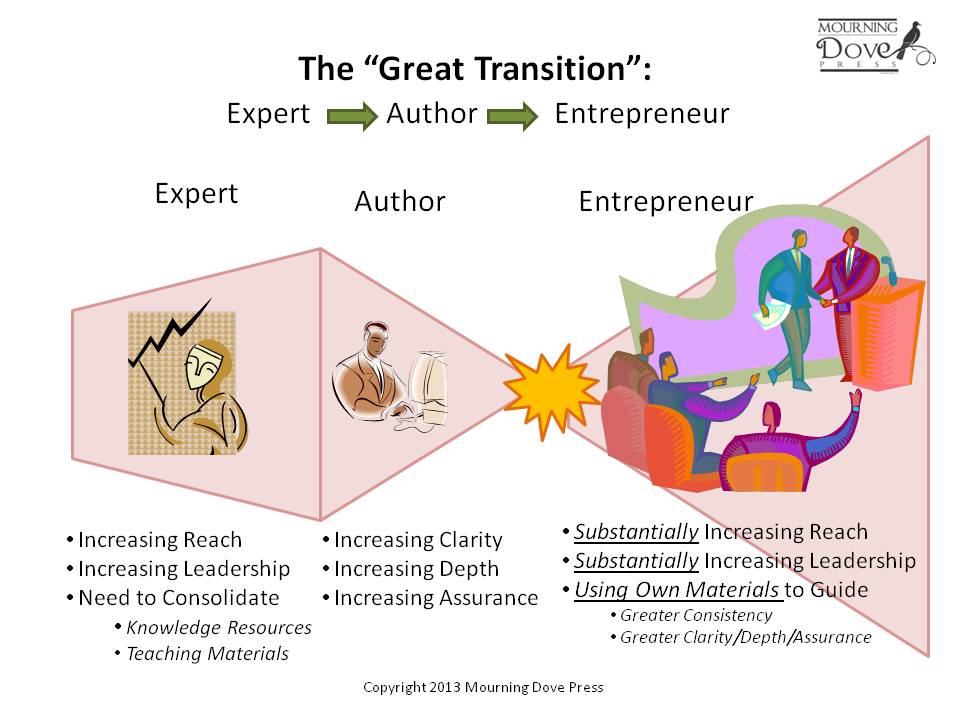Kicking Off the New Year – Determining Goals, Time-Allotments, and Priorities
The toughest thing – for an entrepreneur or author – is figuring out priorities.
Sometimes we have a list of things that need to be done – this week, this month, this year. The challenge is in finding the starting point.
Sometimes, we have a related challenge. This happens when we’ve been in information-gathering mode; when we’ve found various online teachers. They all have good things to offer. This related challenge is: each of these new teachers/gurus/coaches is saying that what they’re teaching is the most important thing.
And our gut tells us that each of them is right.
However, something has to be most right for us at a given moment.
It’s figuring this out that is tough.
I wrote about this as one of the earliest Mourning Dove Press blogposts – Three Biggest Challenges for Authors/Entrepreneurs.
One of these “biggest challenges”? It was figuring our direction – when every direction seems to be true north.
The Three Crucial Questions
When we’re in this spot – many directions in which we could (and ultimately should) go – and trying to figure out our next steps, answering just three questions will help us sort out our priorities:
- What is our necessary baseline platform,
- What depends on what, and
- What has the longest lead time for getting useful results?
Tribe-Building: The Necessary Platform
Like some of you, I’m already an author.
Like many – if not most – of you, I’m an entrepreneur. In fact, a serial entrepreneur – this is my third major start-up.
After publishing my book (Unveiling: The Inner Journey) two and a half years ago, I did what I thought was the right marketing.
But truth was – I understood only part of the engine.
The result? I had a lot of go-nowhere activities; little one-off efforts that didn’t dovetail back into the big picture.
Much of what I did was both useful and necessary.
However, because my priorities were off – because I was missing the core element for Tribe-building – I lost more than a year’s worth of effort.
Not a complete loss – because now that my Tribe-building central core is strong, I can go back and reclaim some of those efforts; bring them back to strengthen the solid core.
You can do the same.
But there’s no strengthening the core if the core isn’t there to begin with, right?
Painful Actions to Remedy a Discordant Situation
Last year (2013), I had to take down the different online business elements that did not work, and build a new structure that did.
This involved three steps:
- Learning what to do,
- Learning how to do what needed doing, and
- Doing it.
Enroute, because I have a life-long habit of teaching that which I need to learn, I started the MDP blog series – that which you’re reading right now.
I was also supremely fortunate to find a client who needed me to do for her that which I was doing for myself.
You know the rule for teaching something to someone (even yourself), right?
- Learn the subject,
- Put into practice what you’ve just learned, and
- Teach it to someone else.
Hence, this blog.
Hence, you’re profiting from my – not so much mistakes, but mis-directions, and lost time.
The best possible result?
You’ll still have to work, and I do mean work (real hard). But then – your efforts will all dovetail nicely. And, one effort will lead to success with another, which will lead to more success, … In short, success will build on itself .
Your Essential Tribe-Building Platform Is …
I talk with a lot of people who say something like Oh, I need to build a website, or I need to update my website.
Wrong.
The basic platform is not your website. (That’s so early 2000’s.)
Your basic Tribe-building Platform is a combination of five crucial elements:
- Website – yes, you still need one,
- Tribe-management system – it lets you keep track of your Tribe and communicate with Tribe members easily,
- First benefits – some people call these an “ethical bribe,” or reason why people should give you their email address (join your Tribe) in the first place,
- First Tribe-building connections, which are the steps you take with someone immediately after they join your Tribe – teaching them how you can and will help them, and
- Loaves and fishes – the regular care and feeding of your Tribe.
Which brings me to Premise #1:
Until your basic Tribe-building Platform is in place, you have no other or stronger priority. This is your Number One Priority.
Getting your Tribe-Building Platform up and running smoothly is a matter of at least a few months. Possibly a whole year.
However, getting your Tribe-building Platform into operation is the first task that answers all three of the crucial questions posited earlier.
Specifically:
- Your Tribe-building Platform is your necessary baseline platform,
- Everything else that you do will hook into your basic Platform or bring more members to your Tribe, and
- Tribe-building is the one activity that has longest lead-time, and must be started early.
With this in mind, you have a framework for making all priority and time-allotment decisions.
For example:
- Networking events – if your platform is not clear and solid, and if you have no reason for people to join your Tribe, then meeting people and getting their business cards will give you only secondary, not primary, benefits,
- Giving talks – a great idea, once the talks become a means for inviting people to join your Tribe (by showing them how much valuable information you give, of course), and
- YouTubes, Facebook, other social media – great adjuncts to your Tribe-building platform, but if they don’t ultimately bring your people to the Platform, and invite them to join your Tribe, you’re doing divergent activities. What you really want is convergent.
What you really want is convergent activities.
Convergent means actions that get people to join your Tribe, and then to strengthen their bond with you and your Tribe.
Joining your Tribe happens when someone takes the first step: they Opt-In to (join) your Tribe through using an Opt-In form on your website, where they give you their name and email address, or at least their email address. This is where the relationship starts.
Ultimately, your Tribe members will realize the transformational value that being part of your Tribe brings to their lives. They’ll want more of what you offer. That’s when you start transacting – because they’ll want to buy what you offer.

Loaves and fishes: feeding your tribe (your Opt-In group) means regularly giving them content that meets their needs.
But your primary objective needs to be teaching your Tribe and giving them transformational tools and insights. They’ll buy in order to get more powerful and effective versions of what you offer for free. (That’s the Loaves and Fishes strategy.)
Doesn’t matter if they give you their business card. Doesn’t matter if you have them in your private database or in any of your distribution lists.
Doesn’t matter how much you email each other, or talk on the phone.
Doesn’t matter if you’re Facebook Friends-for-Life. Doesn’t matter if they even introduce you to their nearest-and-dearest.
They join your Tribe when they Opt-In to at least one of your lists, using an Opt-In form that you’ve put on your website, and you’ve responded by giving them the First Benefit. (This could be a report, a list of useful tools, a first email back with a promise of monthly emails – whatever it is that you promised them when they joined.)
This starts the relationship.
Going Behind the Green Curtain in Oz – Next Steps for Tribe-Builders
We’re going behind the green curtain, and I’ll show you what I’ve learned and deciphered about the magic controls that any Wizard uses to generate big effects.
In the next few months, we’ll deal with the real and practical issues of Tribe-building, from the ground up.
Topics that we’ll address will include:
- Resources – I’m going to introduce you to the people whom I listen to and whose webinars/videos I watch (avidly) – my most-trusted group of advisors, my personal best-of-the-best,
- Tribe transition strategies – how do you bring the people whom you already know into your Tribe? What works over time? and finally –
- Tribe-growing strategies – what works best; what works when. I’ll be sharing the inside secrets of what I’ve learned, what I’ve done, and what works best. And yes; real data, real numbers, real graphs.
Join me!
And hey, if you haven’t already – join my Tribe! Go to the Home Page for Mourning Dove Press, and there – big as can be – a big, ole’ Opt-In Form. Do the right thing. See you on the other side.
Extra Incentive
I’m going to be teaching workshops on the practical, tangible specifics – how to build your Tribe-building Platform.
These will be hands-on, very small group sessions.
You’re going to do the work yourself. But I’ll be there to coach you on every single step.
Plus (because I grew up with a college professor father, and have taught in several universities), you’ll get homework.
That’s right. For-real homework – which you’ll need to complete before you can take the next class.
And you’ll want to take the next class – because it will help you get to the next level of your own Tribe-building.
Now, I know – not all of you can get to McLean, VA for once-a-month Saturday classes. But I’ll be sending out class notes to people who are members of my Tribe.
No fee. But just by becoming a member, you’ll get extra info that I’m not putting into this blog series – just giving my Tribe members a heads-up on where to find it.
- What to do first – and second, and third – I’ll take the mystery out, and make it clear, practical, and simple,
- Step-by-step – online resources to back up class studies, or to help you out if you can’t be in class, and
- Example completed assignments – with comments and corrections – yes, you remember from college days – the answers to the questions are in the back of the book. Well, Tribe members – and Tribe members only – get the crib sheets. The worked-out exercises. You can see what I’ve done, and what I’m doing now, and see how it impacts my growing Tribe.
As best-selling author and life coach Tony Robbins says, when you want to master a new skill or craft:
… find someone who has achieved the results you want and copy what they do and you’ll achieve the same results.
So join me. And join my Tribe! Go to the Home Page for Mourning Dove Press. See you there!







